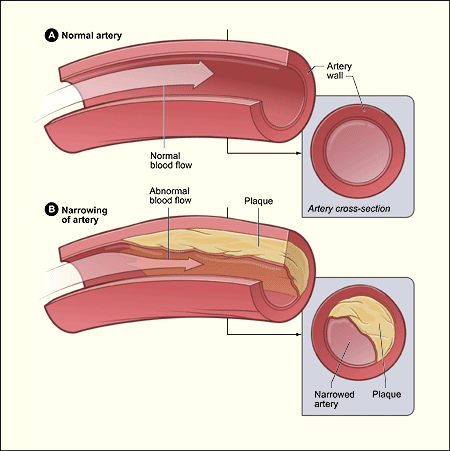What Is Cholesterol?
To understand high blood cholesterol
(ko-LES-ter-ol), it is important to know more about cholesterol.
- Cholesterol is a waxy, fat-like substance that
is found in all cells of the body. Your body needs some cholesterol to work the
right way. Your body makes all the cholesterol it needs.
- Cholesterol is also found in some of the foods
you eat.
- Your body uses cholesterol to make hormones,
vitamin D, and substances that help you digest foods.
Blood is watery, and cholesterol is fatty. Just like
oil and water, the two do not mix. To travel in the bloodstream, cholesterol is
carried in small packages called lipoproteins (lip-o-PRO-teens). The small
packages are made of fat (lipid) on the inside and proteins on the outside. Two
kinds of lipoproteins carry cholesterol throughout your body. It is important
to have healthy levels of both:
- Low-density lipoprotein (LDL) cholesterol is
sometimes called bad cholesterol.
- High LDL cholesterol leads to a buildup of
cholesterol in arteries. The higher the LDL level in your blood, the greater
chance you have of getting heart disease.
- High-density lipoprotein (HDL) cholesterol is
sometimes called good cholesterol.
- HDL carries cholesterol from other parts of
your body back to your liver. The liver removes the cholesterol from your body.
The higher your HDL cholesterol level, the lower your chance of getting heart
disease.
What Is High Blood Cholesterol?
Too much cholesterol in the blood, or high blood
cholesterol, can be serious. People with high blood cholesterol have a greater
chance of getting heart disease. High blood cholesterol on its own does not
cause symptoms, so many people are unaware that their cholesterol level is too
high.
Cholesterol can build up in the walls of your
arteries (blood vessels that carry blood from the heart to other parts of the
body). This buildup of cholesterol is called plaque (plak). Over time, plaque
can cause narrowing of the arteries. This is called
atherosclerosis
(ath-er-o-skler-O-sis), or hardening of the arteries.

The illustration shows a normal
artery with normal blood flow (figure A) and an artery containing plaque
buildup (figure B).
Special arteries, called coronary arteries, bring
blood to the heart. Narrowing of your coronary arteries due to plaque can stop
or slow down the flow of blood to your heart. When the arteries narrow, the
amount of oxygen-rich blood is decreased. This is called
coronary
heart disease (CHD). Large plaque areas can lead to chest pain called
angina
(an-JI-nuh or AN-juh-nuh). Angina happens when the heart does not receive
enough oxygen-rich blood. Angina is a common symptom of CHD.
Some plaques have a thin covering and can burst
(rupture), releasing cholesterol and fat into the bloodstream. The release of
cholesterol and fat may cause your blood to clot. A clot can block the flow of
blood. This blockage can cause angina or a
heart
attack.
Lowering your cholesterol level decreases your
chance for having a plaque burst and cause a heart attack. Lowering cholesterol
may also slow down, reduce, or even stop plaque from building up.
Plaque and resulting health problems can also occur
in arteries elsewhere in the body.
September 2008
|

